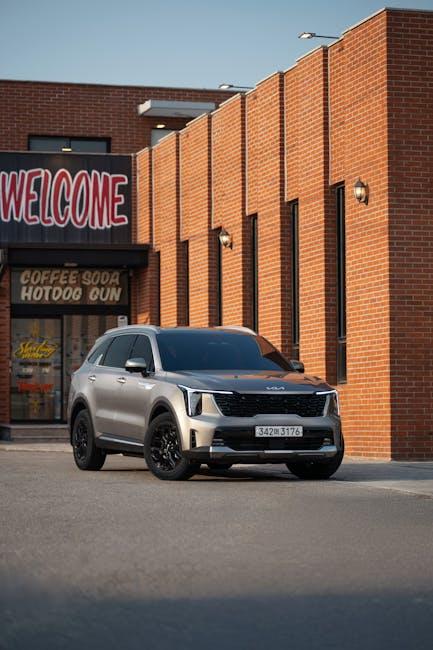Picture this: you’re cruising down the highway, enjoying the hum of your engine, when suddenly a letter arrives in the mail that turns your smooth ride into a moment of concern—a vehicle recall notice. It’s a phrase that can stir a mix of emotions, from frustration to uncertainty. But fear not—handling a vehicle recall doesn’t have to be a headache. In this guide, we’ll navigate the steps to take when your car is called back, transforming a potentially stressful situation into a straightforward process. Whether it’s a minor fix or a major repair, knowing what to do can put you back in the driver’s seat with confidence. Let’s dive in and steer through the recall road together.
Table of Contents
- Understanding the Importance of Vehicle Recalls and Your Safety
- Identifying Recalls on Your Vehicle Through Reliable Sources
- Steps to Take Immediately After Receiving a Recall Notice
- Navigating the Repair Process With Authorized Service Centers
- What to Do If Your Recall Repair Is Delayed or Unavailable
- Maintaining Documentation and Monitoring Your Vehicle’s Safety Updates
- Q&A
- In Retrospect

Understanding the Importance of Vehicle Recalls and Your Safety
Every vehicle recall serves as a crucial reminder that your safety on the road is a top priority. Manufacturers initiate recalls to address defects or potential hazards that, if left unchecked, could jeopardize the well-being of drivers, passengers, and others on the road. Staying informed about recalls ensures you can act swiftly to mitigate risks. Neglecting these alerts might lead to unexpected breakdowns or, worse, accidents caused by faulty components such as brakes, airbags, or seat belts. Your car’s safety isn’t just about routine maintenance; it’s also about recognizing and responding to these recalls with urgency and responsibility.
Being proactive means knowing what steps to take once a recall is announced. Here’s a quick guide to navigating this process:
- Check Your Vehicle Identification Number (VIN): Verify if your car is affected by looking up the VIN on official recall databases.
- Contact Your Dealer: Schedule a free repair service, as dealerships are mandated to fix recalled vehicles at no cost.
- Follow Up: Ensure repairs are completed promptly and keep copies of all recall-related documentation.
To illustrate, consider the table below showcasing how different recall issues impact vehicle components and the typical repair timeframe:
| Recall Issue | Impacted Component | Estimated Repair Time |
|---|---|---|
| Airbag Deployment Fault | Airbag System | 1-2 Hours |
| Brake Fluid Leak | Brake Lines | 2-3 Hours |
| Fuel Pump Malfunction | Fuel System | 3-4 Hours |

Identifying Recalls on Your Vehicle Through Reliable Sources
Staying informed about potential recalls can significantly enhance your vehicle’s safety and reliability. The most trustworthy method to check if your car is subject to a recall is through official channels. The National Highway Traffic Safety Administration (NHTSA) website offers a comprehensive and current database where you can enter your Vehicle Identification Number (VIN) to see if any open recalls apply. Additionally, manufacturers often provide dedicated recall lookup tools on their websites, allowing owners to quickly verify recall status with peace of mind.
Besides online resources, you can also:
- Subscribe to manufacturer newsletters to receive immediate notices about recalls.
- Consult your local dealership, as they have direct access to recall information and scheduled repair timelines.
- Monitor trusted automotive news sites that regularly publish briefings on significant safety alerts.
| Source | Access Type | Key Feature |
|---|---|---|
| NHTSA Website | Free online lookup | Real-time recall data via VIN |
| Manufacturer Sites | Online tools & emails | Direct updates and repair scheduling |
| Local Dealerships | In-person / phone | Hands-on support and recall repairs |

Steps to Take Immediately After Receiving a Recall Notice
Once you receive a recall notice, the first step is to carefully read the entire communication. Understand the specific issue being addressed, how it affects your vehicle, and whether immediate action is required. Keep an eye out for any deadlines or appointment instructions included in the notice. If any safety concerns are highlighted, avoid driving the vehicle until the recall repair is completed. It’s also wise to verify the authenticity of the recall notice via the manufacturer’s official website or government safety agencies to prevent falling victim to scams.
Next, contact your vehicle dealership or authorized service center to schedule an appointment for the repair. Recall fixes are usually covered at no cost, but you should confirm this when booking. Prepare your vehicle information, including the vehicle identification number (VIN), to streamline the process. Meanwhile, keep track of all communications and service documents to maintain a clear record of your compliance. Here’s a quick checklist to help organize your response:
- Confirm the recall details on official platforms
- Review your vehicle’s current condition and safety status
- Locate your vehicle’s VIN for easy reference
- Contact authorized service centers promptly
- Keep all recall-related correspondence and service records

Navigating the Repair Process With Authorized Service Centers
When your vehicle is subject to a recall, relying on an authorized service center is crucial for ensuring the repair is handled correctly and safely. These centers possess specialized training, genuine parts, and manufacturer-backed warranties, which collectively guarantee the integrity of the repair. Before visiting, consider scheduling an appointment through the official communication channels of the authorized center—this helps reduce wait times and aligns your visit with technician availability. Additionally, always have your recall notification and vehicle identification number (VIN) handy to streamline the verification process.
Here’s a checklist to keep your repair experience smooth and stress-free:
- Confirm the recall status and repair eligibility through manufacturer or NHTSA websites.
- Book appointments only with approved authorized centers to maintain warranty validity.
- Ask for detailed documentation of the repair work performed for your records.
- Inquire about alternative transportation options if repairs require extended downtime.
| Step | What to Prepare | Why It Matters |
|---|---|---|
| 1. Verify Recall | Vehicle VIN & Recall Notice | Ensures your vehicle is eligible for free repair |
| 2. Contact Authorized Center | Appointment Scheduling | Prevents delays and ensures technician availability |
| 3. Bring Vehicle & Documentation | Proof of Ownership & Identification | Facilitates smooth service check-in |
| 4. Obtain Repair Confirmation | Service Report | Validates the recall repair is completed properly |

What to Do If Your Recall Repair Is Delayed or Unavailable
When facing delays or unavailability in recall repairs, it’s crucial to stay proactive. First, maintain open communication with your dealership or the manufacturer. They may provide estimated timelines, interim safety measures, or alternative repair locations. Simultaneously, document all correspondence and keep your recall notification handy. This record can prove vital if you need to escalate the issue later.
You should also consider the following steps to protect yourself and your vehicle:
- Limit vehicle use: Avoid unnecessary trips, especially if the recall involves critical components like brakes or airbags.
- Check for workaround solutions: Some manufacturers offer temporary fixes or safety guidelines until full repairs are possible.
- Explore third-party options: Verify with your automaker if approved independent shops can perform the recall-related repair.
- Know your consumer rights: In some regions, laws protect you if a recall repair is unreasonably delayed.
| Action | Why It Helps |
|---|---|
| Contact Manufacturer Hotline | Get updates and express concerns directly |
| Use Alternate Transportation | Reduce use of affected vehicle, ensuring safety |
| Keep Repair Documentation | Useful for legal or warranty claims |
| Consult Consumer Protection | Know your rights regarding recall delays |

Maintaining Documentation and Monitoring Your Vehicle’s Safety Updates
Properly safeguarding your vehicle’s well-being after a recall begins with organized and up-to-date documentation. Keep all recall notifications, repair receipts, and correspondence neatly filed—either digitally or in a dedicated folder. This not only simplifies follow-up but also ensures you have proof of compliance should future questions arise. Additionally, using a trusted app or your vehicle manufacturer’s website to log completed repairs can help keep your service history current and accessible.
Staying vigilant about new safety updates is equally crucial. Recall information evolves, and manufacturers sometimes issue additional notices regarding your model. Regularly check official channels such as:
- National Highway Traffic Safety Administration (NHTSA) recall database
- Your vehicle manufacturer’s recall alert system
- Authorized dealership service departments
These proactive steps ensure you never miss critical safety updates that protect you and your passengers long after the initial recall has been addressed.
Q&A
Q&A: How to Handle a Vehicle Recall
Q1: What exactly is a vehicle recall?
A: A vehicle recall is when a manufacturer discovers a defect or safety issue in a specific model or batch of cars and requests owners to bring their vehicles in for free repairs or replacements to fix the problem.
Q2: How will I know if my vehicle has been recalled?
A: Manufacturers notify owners via mail, email, or phone if their vehicle is affected. You can also check official databases like the National Highway Traffic Safety Administration (NHTSA) website by entering your Vehicle Identification Number (VIN).
Q3: What should I do first if I learn my vehicle is subject to a recall?
A: Don’t panic! First, verify the recall by checking the official source. Then, read the recall notice carefully to understand the issue and how urgent it is. Finally, schedule an appointment with your dealer for the repair.
Q4: Are recall repairs always free?
A: Yes, recall repairs mandated by the manufacturer are at no cost to the vehicle owner. Dealerships must fix the problem without charging for parts or labor.
Q5: Can I continue driving my vehicle if it’s under recall?
A: It depends on the severity of the defect. Some recalls involve critical safety issues and advise you not to drive the vehicle until fixed. Others might be less urgent. Always follow the recall notice’s recommendations.
Q6: What if the dealership says the repair will take a long time or is inconvenient?
A: Recall repairs should be prioritized. If delays occur, ask if there’s a loaner vehicle or alternative solutions. You can also contact the manufacturer’s customer service or a consumer protection agency for assistance.
Q7: Can a recall affect my vehicle’s resale value?
A: It might, but once a recall repair is performed and documented, it generally restores the vehicle’s safety and reliability, minimizing negative impact on resale value.
Q8: Is it possible to sell a vehicle that has an unresolved recall?
A: You can sell it, but it’s best practice—and sometimes legally required—to inform the buyer about the recall status. Unresolved recalls can pose safety risks and liabilities.
Q9: How can I stay informed about future recalls on my vehicle?
A: Register your vehicle with the manufacturer if possible, regularly check government recall websites, and keep your contact information updated with your dealer or manufacturer to ensure you receive timely notifications.
Q10: What if the manufacturer refuses to fix my recalled vehicle?
A: This is rare, but if it happens, contact consumer protection agencies or legal advisors. Federal laws mandate manufacturers to repair safety recalls free of charge.
Handling a vehicle recall needn’t be stressful. With prompt attention, informed action, and a little patience, you can keep your ride safe and smooth on the road.
In Retrospect
Navigating a vehicle recall might feel like unexpected turbulence on an otherwise smooth ride. But with the right knowledge and a calm approach, you can steer through the process confidently and safely. Remember, recalls are designed to protect you and your vehicle, ensuring that every journey remains as reliable as it should be. Stay informed, act promptly, and keep your wheels turning with peace of mind. After all, taking the right steps today means a smoother road ahead.
